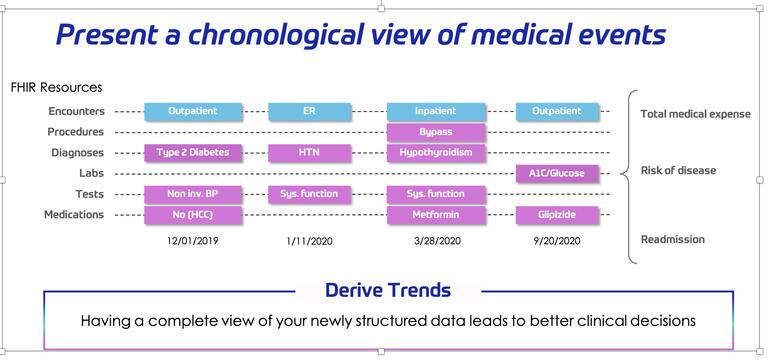We use cookies to enhance your browsing experience, serve personalized ads or content, and analyze our traffic. By clicking "Accept All", you consent to our use of cookies.

To say that the healthcare industry is awash with data would be an understatement. Patient records, medical images, genomic sequencing, disease registries, pharmaceutical research, IoMT devices, and wearables — the sources of big data in healthcare are numerous and versatile. In addition to the ever-increasing volume, health data is also locked in different types and formats. About 80% of health data is unstructured, which makes it difficult to interpret and analyze with conventional databases.
This data, however, is crucial to transforming healthcare from volume-based to value-based as it harbors actionable insights into patient populations and care processes. To help healthcare providers do the heavy lifting, Amazon has added HealthLake to the roster of its services. Rolled out at AWS re:invent 2020, HealthLake is a component of AWS for Health initiative aimed to accelerate the pace of healthtech innovation through a set of readily accessible cloud-based tools.
AWS HealthLake is a HIPAA-eligible service designed to help healthcare and life sciences (HCLS) clients to ingest, store, structure, and analyze health data at scale.

Source: Amazon HealthLake
With the support for both structured and unstructured data, HealthLake seamlessly pulls health data from a variety of sources and on-premise systems and merges it into a centralized repository while structuring it into the Fast Healthcare Interoperability Resources (FHIR) format. The FHIR standard facilitates safe and secure sharing of health information across the entire healthcare continuum and supports more effective collaboration between providers. If a customer’s data is not in the FHIR format, AWS HealthLake includes connectors like Redox, Diameter Health, HealthLX, and InterSystems for easy conversion from HL7v2 and CCDA to FHIR.
The service further leverages natural language processing (NLP) to extract meaningful information from clinical data, tag each piece of health information, index events, and even add standardized labels (conditions, diagnoses, procedures, and more) to make the data easily searchable.
To top it off, HCLS customers do not have to worry about provisioning and maintaining a data lake since HealthLake is built on fully-managed cloud AWS infrastructure. Setting up a new data store with HealthLake takes only a few minutes, and then users can immediately update, delete, and query health data.
HealthLake was launched to help healthcare providers and insurance companies address one of the key challenges of today’s healthcare — transitioning to a value-based model and improving patient outcomes. Let’s walk through some examples of how HealthLake helps do that.
Clinical decision-making is a complex process that depends on the completeness and accuracy of data in order to be effective. That’s not always the case when a patient’s data is scattered across different systems and organizations.
As discussed above, HealthLake aggregates health data from relevant health applications under one roof, creating a 360-degree view of a patient’s medical history. The solution tags key pieces of information and indexes events in chronological order to enable clinicians to perform quick search throughout the entire medical database by using standard medical terms. Having a complete, timeline view of a patient’s health data, including encounters, diagnoses, and prescriptions, helps healthcare professionals make informed decisions that are deep-rooted in data.
 Source: TechRepublic
Source: TechRepublic
Not only does HealthLake provide a complete overview of a patient’s data, but the platform also allows healthcare providers to zoom out and have a look at health data at the population level.
To that end, AWS Glue, a serverless ETL tool, is used to prepare data for analysis, and Amazon Athena, a query service, is applied to run standard SQL queries on tables in a data catalog. Then, Amazon QuickSight, a cloud-based BI service, uses data from Athena tables to create easy-to-interpret charts and data visualizations. Depending on the use case, QuickSight-based dashboards can include a variety of filters like the number of patients, demographics, the number of encounters, the average length of hospital stay, and more.
Source: AWS
Predictive analytics is at the forefront of many AWS services, and HealthLake is no exception. To help healthcare providers unlock the true value of health information, HealthLake provides a reliable foundation for performing ML-powered analysis on top of normalized and enriched medical data. By using Amazon SageMaker, AWS customers can build tailored ML models to uncover trends in disease progression, identify opportunities for early intervention, predict patient outcomes, deliver personalized medicine, and more.
In this example, the authors built an ML-powered model for predicting congestive heart failure (CHF) — a major healthcare concern with the direct and indirect costs exceeding $30 billion annually just in the US. The model was trained on the MIMIC-III dataset (including demographics, medications, vital signs) and augmented with data extracted from unstructured clinical notes. By adding these features, the authors managed to boost the model accuracy from 85% to 89%, while also reducing false positives and false negatives.
To illustrate the case in point, two word clouds were prepared for top medical conditions where model 2, built with unstructured notes from HealthLake, was richer and more indicative of CHF.

Source: AWS Machine Learning Blog
Armed with this level of accuracy, practitioners can make better patient outcome predictions, tailor intervention strategies, and implement risk reduction measures to delay or even avert the development of a disease.
Another area where HealthLake can make a difference is clinical R&D initiatives. Researchers are facing the growing volumes of medical data that come from trial sites, contract research organizations, EHRs and EMRs, wearables, and medical devices.
By tagging, indexing, and structuring every piece of clinical evidence, HealthLake supports a smarter cognitive search by allowing clinicians to simply type a natural language question. When HealthLake output is connected to Amazon Neptune and Kendra, HCLS customers can build graph applications to surface the results in an easy-to-interpret way, reveal connections between key entities, run patient cohort analysis, translating into more effective clinical trials.
Over the recent years, there has been an explosion of health data but unlocking the true value of it is still riddled with challenges. Amazon dives deeper into health data analytics with its new HIPAA-eligible service HealthLake. In addition to secure data storage, HealthLake offers easily accessible machine learning capabilities that help healthcare organizations enhance the quality of care, tailor a more personalized approach, and improve patient outcomes.



